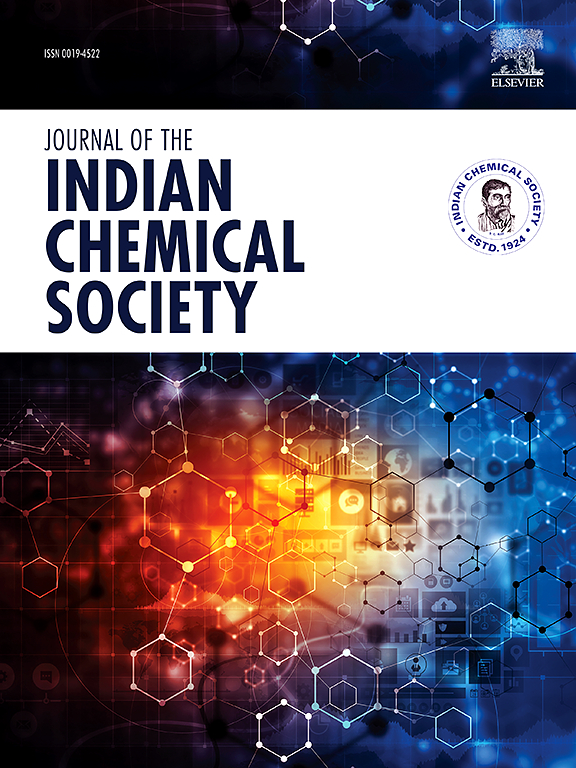Binding and dynamics of diferuloylmethane-pyrimidine with C-Met protein
IF 3.2
4区 化学
Q2 CHEMISTRY, MULTIDISCIPLINARY
引用次数: 0
Abstract
C-Met protein antagonism is a prominent target for suppressing tumour growth. This study fabricates a new diferuloylmethane analogue by forming a ring in the mid-ketonic group and investigates its anticancer potential. First, molecular contact with the active site amino acids of 5AY5 was analysed through binding energy calculation. The best binding pose was submitted to an MD simulation in SPC solvent model for the interaction stability prediction. Further, the stable molecule was subjected to DFTB module to confirm the chemical reactivity. The result of diferuloylmethane analogue interaction with C-Met protein illustrates that the binding affinity was found to be −9.032 kcal/mol and the binding free energy of −71.73 kcal/mol for the molecule diferuloylmethane pyrimidine moiety. It formed π-π stacked and H-bond interactions with the C-Met protein. A 100 ns simulation tracked the diferuloylmethane-pyrimidine stabilized within <0.5 Å and strong interactions with more than 25 amino acids. Among these, TYR1230 had a 54 % with additional π-π stacked interactions formed. Compared to a standard molecule, it was more stable and formed a greater interaction. DFT studies depicted that electrostatic, hydrogen bonding, and hydrophobic interactions enhance the molecule's binding potential. Orbital calculations revealed a gap of 2.5479 eV, and thermodynamic behaviour suggesting increased stability and reduced chemical reactivity. These computational findings indicated that the diferuloylmethane–pyrimidine derivative shows potential as a C-Met inhibitor in cancer therapy.
二乙基甲烷-嘧啶与C-Met蛋白的结合及动力学
C-Met蛋白拮抗剂是抑制肿瘤生长的重要靶点。本研究通过在中酮基上形成一个环,制备了一种新的异丙基甲烷类似物,并研究了其抗癌潜力。首先,通过结合能计算分析了5AY5与活性位点氨基酸的分子接触。在SPC溶剂模型中对最佳结合位姿进行了MD模拟,以预测其相互作用的稳定性。进一步,对稳定分子进行DFTB模块验证化学反应性。二脲基甲烷类似物与C-Met蛋白相互作用的结果表明,二脲基甲烷嘧啶部分的结合亲和力为- 9.032 kcal/mol,结合自由能为- 71.73 kcal/mol。它与C-Met蛋白形成π-π堆叠和氢键相互作用。100 ns模拟跟踪了稳定在<;0.5 Å内的二乙基甲烷-嘧啶,并与超过25种氨基酸强相互作用。其中,TYR1230具有54%的额外π-π堆叠相互作用形成。与标准分子相比,它更稳定,形成了更大的相互作用。DFT研究表明,静电、氢键和疏水相互作用增强了分子的结合势。轨道计算结果显示,其间隙为2.5479 eV,热力学行为表明其稳定性增加,化学反应性降低。这些计算结果表明,二苯基甲烷-嘧啶衍生物在癌症治疗中具有作为C-Met抑制剂的潜力。
本文章由计算机程序翻译,如有差异,请以英文原文为准。
求助全文
约1分钟内获得全文
求助全文
来源期刊
CiteScore
3.50
自引率
7.70%
发文量
492
审稿时长
3-8 weeks
期刊介绍:
The Journal of the Indian Chemical Society publishes original, fundamental, theorical, experimental research work of highest quality in all areas of chemistry, biochemistry, medicinal chemistry, electrochemistry, agrochemistry, chemical engineering and technology, food chemistry, environmental chemistry, etc.

 求助内容:
求助内容: 应助结果提醒方式:
应助结果提醒方式:


